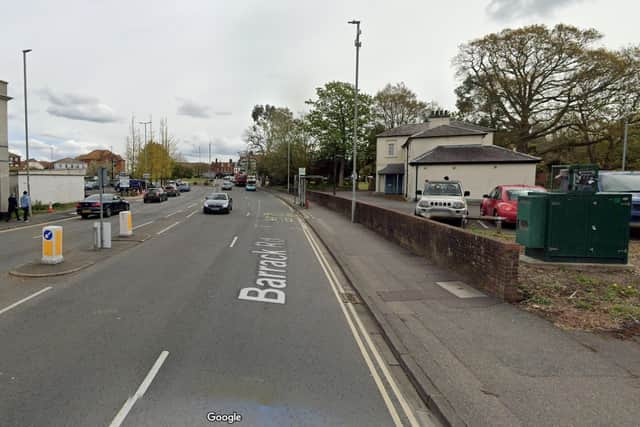Air pollution hotspots UK: worst areas that breach WHO safety levels - including Dorset, Kent and Essex
and live on Freeview channel 276
Levels of dangerous air pollution particles breached world safety guidelines at almost all UK monitoring points last year, analysis of official figures shows.
The mother of a schoolgirl killed by toxic air has called for urgent action, saying she didn’t “want any more children to die”.
Advertisement
Hide AdAdvertisement
Hide AdAt one in ten of the sites, levels were double those deemed safe by the World Health Organisation (WHO), NationalWorld’s analysis of the Government data shows.
Perhaps surprisingly, the worst hotspots were outside of London, by busy A-roads in leafy parts of southern England. But levels of the particles remained within current UK legal limits at all 60 monitored sites, prompting campaigners to call on Prime Minister Liz Truss to “go further and quicker” in tightening the rules.
The Department for Environment, Food and Rural Affairs (DEFRA) said it aimed to cut people’s exposure to particulate pollution by more than a third by 2040, compared with 2018 levels.


‘My daughter would still be alive today’
Nine-year-old Ella Adoo-Kissi-Debrah, of Lewisham, London, died from an asthma attack in 2013 and was the first person in the UK to have air pollution listed as a cause of death.
Advertisement
Hide AdAdvertisement
Hide AdHer mother, Rosamund Adoo-Kissi-Debrah, called for a nationwide information campaign, saying: “Had I known about the dangers of air pollution, and walking by polluted roads, my daughter would still be alive today. I don’t want any more children to die from something that we already have the tools and the economic case to solve.”


Ms Adoo-Kissi-Debrah set up the Ella Roberta Foundation to campaign for cleaner air in her daughter’s memory.
She said: “Air pollution is a public health emergency and a question of social justice. The government’s own data shows us this, and the facts are not in doubt. Every new study confirms what we already know: that this is a pandemic that requires urgent and coordinated action.


“We don’t all breathe the same air: if you’re poor, you’re more likely to live in areas of high particulate pollution. But this is an issue that affects everyone, with studies suggesting links to dementia, lung and brain cancer, as well as the exacerbation of asthma which is damaging the lives of so many of our children.”
Advertisement
Hide AdAdvertisement
Hide AdFriends of the Earth’s air pollution campaigner, Jenny Bates, said: “For far too long too little has been done to protect people from the scourge of air pollution, which particularly affects the young, the elderly and the most disadvantaged.
“Particular action is needed to cut levels of the most health damaging fine particles, which can get deep into the lungs and bloodstream and can lead to disease and early death.”
What is particulate pollution?
Particulate matter is everything in the air that is not a gas. The tiniest particles, known as PM2.5, are particularly hazardous to health because they can pass through the lungs into the bloodstream, potentially damaging other organs.
These fine particles, far smaller than the width of a human hair, are known to cause asthma, chronic obstructive pulmonary disease and lung cancer. They come mainly from traffic fumes, but also through industrial processes and wood and coal fires.
Advertisement
Hide AdAdvertisement
Hide AdLast year, the WHO halved its guideline for a safe amount from 10 to five micrograms per cubic metre. But many monitoring sites across the UK continue to record higher amounts of the pollutant.
Which areas are the most polluted?
Overall, levels of particulate pollution and death rates associated with this dirty air are highest in London, official modelling for 2020 shows.
Loading....
This modelling also shows high pollution levels in places like Portsmouth and Dartford in the South East.
But more precise measurements are taken at 68 points across the UK, 60 of which recorded reliable readings for 2021. Of these 60 sites, all but two recorded annual average levels above this WHO safety threshold. Seven recorded levels which were more than double this.
Advertisement
Hide AdAdvertisement
Hide AdThe hotspot with the dirtiest air last year was a monitoring site off the A35 dual carriageway through Christchurch in Dorset, with an average 12.5 micrograms per cubic metre.


The local authority, Bournemouth, Christchurch and Poole Council, said the PM2.5 level was within current legal limits.
A spokesperson said: “The purpose of an Urban Traffic site is that it is located very close to the road measuring the concentrations from the road and is not close to any residents’ properties. We will continue to assess the situation as part of our air quality monitoring programme.”
Loading....
The site with the second highest level of PM2.5. was on the A2 in Chatham, Kent, with an average reading of 12.3 micrograms per cubic metre. The third highest was on the A1014 at Stanford-le-Hope, Essex, with an average reading of 11.9 micrograms per cubic metre.
Advertisement
Hide AdAdvertisement
Hide AdMs Bates said there could be many factors causing these hotspots to return higher readings than sites in London.
Loading....
She said they were all in the south of England and could be affected by pollution spreading across from mainland Europe, while busy roads and persistent local sources of pollutants could also play a part.
The data comes from the Automatic Urban and Rural Network (AURN), one of the UK’s air quality monitoring networks. One subset of the sites monitors pollution levels near busy roads while another records more general background readings in urban areas.
These figures show that over the long term, particulate air pollution levels are falling.
Advertisement
Hide AdAdvertisement
Hide AdLoading....
In the past 10 years, average readings at roadside sites have nearly halved, falling from 16 micrograms per cubic metre in 2011 to 8.3 micrograms per cubic metre in 2021.
At background sites, average levels fell by 42% over the same timeframe, from 13.7 to 7.9 micrograms per cubic metre.
How dangerous is air pollution?
Levels of disease caused by air pollution are on a par with those caused by smoking, according to the WHO. It estimates that air pollution causes 4.2 million early deaths worldwide each year.
Unveiling tougher new guidelines for pollutant levels last year, it said there was “now a much stronger body of evidence to show how air pollution affects different aspects of health at even lower concentrations than previously understood”.
Advertisement
Hide AdAdvertisement
Hide AdParticulate air pollution contributed to one in every 18 deaths of over-30s in England in 2020, according to Government estimates.
The figures, from the Office for Health Improvement and Disparities, show the death rate was highest in London, with one in every 14 deaths of over-30s thought to be linked to air pollution.
Loading....
And it rose to eight in every 100 deaths of over-30s in five London boroughs: Newham, City of London, Tower Hamlets, Lambeth and Hackney.
Outside London, the five council areas with highest estimated death rates were Medway, Portsmouth, Dartford, Gravesham, and Slough - all in the South East. In each area, seven in every 100 deaths of over-30s was attributed to air pollution in 2020.
Advertisement
Hide AdAdvertisement
Hide AdThese estimates saw a dip in 2020 because coronavirus restrictions reduced pollution levels, and may have since risen.
What are the laws around air pollution particles?
The current legal limit for PM2.5 in the UK is 20 micrograms per cubic metre, four times the level recommended by the WHO.
The Scottish Government has introduced a tougher limit of 10 micrograms per cubic metre in Scotland.
DEFRA aims to cut the UK limit to 10 micrograms per cubic metre by 2040, as well as reducing the exposure to the population by 35% within the same timeframe.
Advertisement
Hide AdAdvertisement
Hide AdA spokesperson said this would make a significant contribution to public health, resulting in up to 214,000 fewer cases of cardiovascular disease, 56,000 fewer strokes, 70,000 fewer cases of asthma and 23,000 fewer cases of lung cancer over the course of 18 years.
But campaigners called for the Government to go further and faster. Ms Adoo-Kissi-Debrah urged the Prime Minister to bring the UK legal limit down to match the WHO guidelines, by 2030 at the latest.
A private members’ bill going through Parliament aims to set up ‘Ella’s Law’, which would establish a right to clean air and set up a commission to oversee government actions and progress.
And Ms Bates also called for further action, saying: “The new Prime Minister must go further and quicker to reduce pollution from PM2.5. The planned target should be brought forward to 2030, with tougher World Health Organisation levels achieved shortly after.
Advertisement
Hide AdAdvertisement
Hide Ad“Road building plans must be scrapped and more must be done to reduce traffic because particulate pollution also comes from braking and tyre wear – and not just exhausts. More must also be done to encourage people to use alternatives to driving with cheap and convenient public transport and investment in better and safer facilities for cyclists and pedestrians.”
Comment Guidelines
National World encourages reader discussion on our stories. User feedback, insights and back-and-forth exchanges add a rich layer of context to reporting. Please review our Community Guidelines before commenting.
